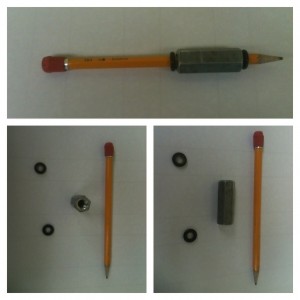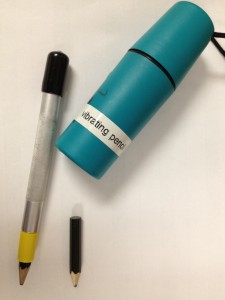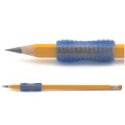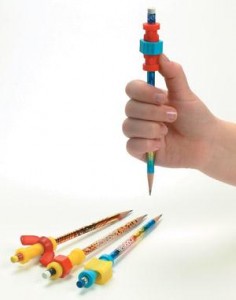Handwriting is a complex skill that can be very difficult for children with sensory processing challenges. Consequently, these children tend to avoid writing because it can be quite frustrating for them. There are different types of writing tools that offer sensory solutions for these children to help make writing an easier task. Here are some tools that may be helpful in exploring ways to best suit your child’s writing & sensory needs.
Mechanical pencils
Children with proprioception problems often have difficulty modulating the pressure they use on items. If a child presses too hard when writing their hands fatigue quicker, mistakes are harder to clear away when erasing, and they are more apt to rip the paper (very frustrating!). Mechanical pencils can aid to teach modulation of pressure, as the lead will break if too much pressure is applied. Each time the lead breaks it will give the child feedback and the desired result is to help them monitor the pressure they are using.
Weighted pencils

While some children with proprioception difficulties press too hard, others press too light when writing making their strokes very hard to decipher. A weighted pencil can help to make their pencil steadier and give them the extra weight they need to press more firmly resulting in darker strokes. There are pencil weight kits that you can purchase or you can easily make one from using rubber washers and rod shaped coupling nuts found in a hardware store for a few dollars.
Vibrating Pencils
Children with low muscle tone generally have poor fine motor strength and have difficulties sustaining their grasp on a pencil, which impacts their written production. Vibration is a sensory technique that can be used to “wake up” or stimulate muscles and
 allow for more efficient muscle use. The vibration pencil also seems to entice children with sensory seeking behaviors, as it gives them sensory feedback to their fingers and helps to keep them focused on the task. Based on my experience, the vibration pencil, more specifically the Ark Z-Vibe*, has been so useful in motivating so many children to write. I often recommend using for homework, as the slight buzz can be distracting to classmates. On the flip side, the constant light hum (like white noise) can be somewhat soothing to the writer. I have noted that children with tactile sensitivity have said it “tickles” their fingers and they do not prefer to use it.
allow for more efficient muscle use. The vibration pencil also seems to entice children with sensory seeking behaviors, as it gives them sensory feedback to their fingers and helps to keep them focused on the task. Based on my experience, the vibration pencil, more specifically the Ark Z-Vibe*, has been so useful in motivating so many children to write. I often recommend using for homework, as the slight buzz can be distracting to classmates. On the flip side, the constant light hum (like white noise) can be somewhat soothing to the writer. I have noted that children with tactile sensitivity have said it “tickles” their fingers and they do not prefer to use it.
Tactile Writing Tools
Tactile seekers love textures. The three options below can help offer sensory feedback to satiate tactile needs during writing tasks by giving them textures right there on their own pencil.
Pencil Toppers
Some children seek intense oral input. These are the children that chew on the collars or sleeves of their shirts, suck on their fingers, or bite off the eraser tips of their pencils. The mouth is a powerful organizing center, just think of how a baby soothes himself by sucking on a pacifier. The actions of chewing, biting, and sucking are excellent ways to help increase focus and concentration and often decrease anxiety.
 CHEW STIXX PENCIL TOPPERS (BPA and Phathalate free) fit right on the top of the pencil and are an excellent sensory strategy to use in the classroom.
CHEW STIXX PENCIL TOPPERS (BPA and Phathalate free) fit right on the top of the pencil and are an excellent sensory strategy to use in the classroom.
Considerations: Using writing tools that give sensory feedback can be very beneficial to a child with sensory needs. It is, however, important to remember that physically holding a pencil properly with a comfortable, efficient grasp is fundamental to developing good handwriting skills.
— Sari Ockner, OTR/L
* Please note that in addition to the Z-vibe you need to purchase the pencil attachment pack and batteries.







Leave a Reply